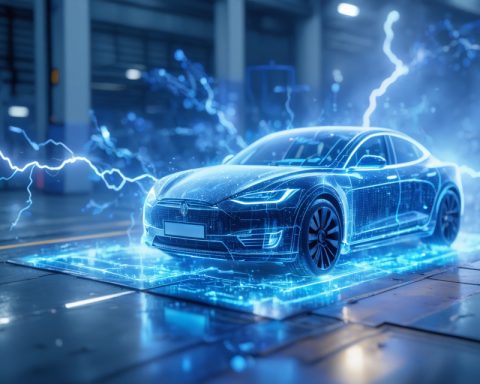- Electric vehicles (EVs) promise a cleaner, quieter future, powered by advanced lithium-ion batteries.
- EV batteries consist of thousands of cells, orchestrating energy storage and release for optimal performance.
- Advanced thermal management systems enhance battery performance and longevity.
- Continuous innovation aims to extend EV battery life and range with new materials and designs.
- Solid-state batteries offer potential improvements in energy density, charging times, and safety.
- The global shift to electric transportation is bolstered by supportive markets and legislation.
- Understanding EV battery technology is key to advancing sustainable transportation and achieving environmental goals.
Silent in operation yet powerful in promise, electric vehicles (EVs) herald a cleaner future. However, beneath the sleek exteriors and high-tech dashboards lies what could be called the heart and soul of any electric vehicle: its battery. Understanding the subtleties of EV batteries not only demystifies the technology but also reshapes our grasp of automotive evolution.
Imagine speeding through a sunlit highway, the whisper of tires on the asphalt and the occasional chirp of a distant bird the only sounds. This serene journey is powered by a complex symphony of chemical reactions occurring within a lithium-ion battery. These powerhouses bravely shoulder the dual burden of performance and sustainability. Yet, despite their ubiquity, how many of us truly understand what unfolds beneath the metal casing?
EV batteries contain thousands of individual cells that combine to form giant packs, each cell an arena where energy storage and release take place. Just like any superhero team, these cells must synchronize flawlessly for optimal performance. Advanced thermal management systems work tirelessly to keep everything cool—and efficiency at its peak. Chargers breathe life into these cells at home, at work, or on the road, transforming electrons into energy that propels cars silently along their journeys.
Yet, innovation never rests. Engineers continually explore how to extend the life and range of EV batteries, delving into the periodic table for new materials or concocting inventive cell designs. Solid-state batteries, often likened to alchemical silver bullets, promise greater energy densities and faster charging times, all while making safety strides. Their potential beckons a future where the dreaded “range anxiety”—that looming question of whether the car will outlast the journey—becomes a relic of the past.
As the world pivots towards an electric horizon, batteries stand at the crossroads. Their story is one of relentless innovation, where chemistry meets engineering in a dance of electrons that could chart the future of transport. This enthusiasm is echoed in markets and new legislations favoring zero-emission vehicles, painting a picture of cleaner skies and quieter cities.
The takeaway for everyone is clear: understanding and supporting the science behind EV batteries can power the shift towards more sustainable transportation, nourishing a collective dream of a brighter, greener planet. So, next time you glide past a gas station in your electric charger, consider the unseen forces at work, silently but efficiently shaping the future of mobility.
The Incredible Dynamics of EV Batteries: What Lies Beneath and Beyond
Electric vehicles (EVs) are silently redefining the future of transportation, promising cleaner, more sustainable mobility. At the heart of this revolution is the EV battery—a marvel of modern engineering and chemistry. In this article, we delve deeper into the fascinating world of EV batteries, exploring their intricacies, innovations, and implications.
How Do EV Batteries Work?
EV batteries are primarily powered by lithium-ion cells. These cells are structured to allow for efficient energy storage and release. Here’s a closer look at their operation:
1. Battery Composition: Each battery pack consists of thousands of individual cells grouped into modules to achieve the desired voltage and capacity. Inside these cells, lithium ions move from the anode to the cathode and back, generating electric current.
2. Thermal Management: Effective temperature control is crucial for battery efficiency and longevity. Advanced thermal management systems regulate the battery’s temperature, ensuring it remains within optimal operating limits.
3. Charging Process: Charging an EV involves transmitting electrical energy from a power source to the battery. This can be done using various types of chargers, from home-installed systems to rapid public charging stations.
Innovations in Battery Technology
Engineers and scientists constantly push the boundaries of battery technology to enhance EV performance and user experience. Here are some innovations on the horizon:
– Solid-State Batteries: These batteries use a solid electrolyte instead of a liquid one, promising higher energy densities and faster charging times. They also reduce the risk of overheating and fires, thanks to their stable structure.
– Recycling and Sustainability: Researchers are improving recycling technologies to reclaim and reuse materials from spent batteries, reducing environmental impact and resource consumption.
Real-World Use Cases
The advancing battery technologies have multiple implications in various domains:
– Extended Range: With improved energy densities, future EVs will travel longer distances on a single charge, alleviating concerns about range anxiety.
– Faster Charging: Innovations are paving the way for rapid charging solutions that can replenish batteries in minutes rather than hours.
Market Forecasts and Trends
The EV market is expanding rapidly, driven by increasing consumer demand and favorable policies:
– Growth Projections: According to various industry reports, the global EV market is expected to grow at a compound annual growth rate (CAGR) of over 20% till 2030.
– Legislation and Incentives: Many countries are introducing zero-emission regulations and incentives to accelerate the adoption of electric vehicles.
Pros and Cons Overview
Pros:
– Eco-friendly, reducing carbon emissions.
– Lower operating costs compared to conventional vehicles.
– Quieter and smoother driving experience.
Cons:
– Higher upfront costs.
– Limited charging infrastructure in certain regions.
– Battery degradation over time may require replacement.
Actionable Recommendations
– Support EV Initiatives: Participate in community initiatives promoting EV infrastructure development.
– Educate Yourself: Stay informed about the latest advancements in battery technology and EV models.
– Optimize Charging Habits: Use smart charging strategies to maintain battery health and efficiency.
Conclusion
Understanding EV batteries not only enhances appreciation for this technology but also empowers informed decisions as the world transitions to sustainable transportation. For more on electric vehicles and sustainability, visit Tesla or Nissan. By embracing these technological advancements, we can all contribute to a cleaner and quieter future on our roads.















